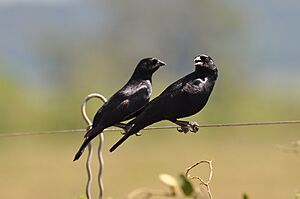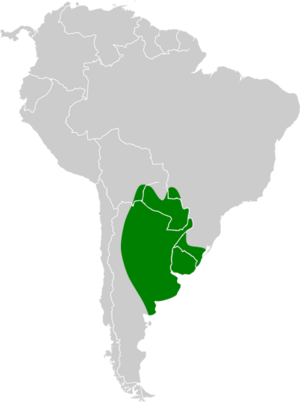Screaming cowbird facts for kids
Quick facts for kids Screaming cowbird |
|
|---|---|
 |
|
| Conservation status | |
| Scientific classification | |
| Genus: |
Molothrus
|
| Species: |
rufoaxillaris
|
 |
|
| Range of the screaming cowbird | |
The screaming cowbird (Molothrus rufoaxillaris) is a bird found in South America. It's known for being an obligate brood parasite, which means it always lays its eggs in the nests of other birds. It belongs to the Icteridae family and is sometimes called the short-billed cowbird.
Contents
What Does It Look Like?
The screaming cowbird has shiny black feathers. The feathers under its wings are a reddish-brown color. Female birds are a bit less shiny than males. Their legs are black, and their eyes are reddish-brown.
These birds are about 18 to 21 centimeters (7-8 inches) long. Males usually weigh around 58 grams, and females weigh about 48 grams.
Their calls are loud and sharp, often described as "screaming notes." They also make rough, rasping sounds. Screaming cowbirds are usually seen in pairs or small groups.
Where Do Screaming Cowbirds Live?
You can find screaming cowbirds in parts of South America. They live in central Brazil, south-east Bolivia, north-east and central Argentina, and all over Paraguay and Uruguay.
Their favorite places to live are grasslands and pastures. They often look for food near grazing animals like cows, which is how they got the name "cowbird." Like other cowbirds, they mostly search for food on the ground. They eat small insects and other invertebrates that are stirred up by the grazing animals.
The number of places where screaming cowbirds live has grown a lot recently. This is because of changes to habitats, like deforestation (cutting down forests). They also follow their host birds into new areas. Both male and female screaming cowbirds tend to stay in the same roosting (sleeping) spots.
Life Cycle and Reproduction
Who Are Their Host Birds?
The screaming cowbird is a special kind of brood parasite. This means it lays its eggs in the nests of other bird species instead of building its own nest. It mostly uses the nests of baywings (Agelaioides). In 1874, a person named W. H. Hudson first noticed this special relationship. He saw what he thought were baywing chicks change into screaming cowbird chicks as they grew.
Screaming cowbirds also sometimes lay eggs in the nests of the chopi blackbird (Gnorimopsar chopi) and the brown-and-yellow marshbird (Pseudoleistes virescens). This usually happens in places where baywings are not around. All three of these host species are cooperative breeders. This means other birds, called "helpers," assist with feeding the chicks and protecting the nest from predators.
How Do Screaming Cowbirds Behave?
Screaming cowbirds stay with one partner during the breeding season. Since they are obligate brood parasites, they do not build their own nests. Instead, they lay their eggs in the nests of other species, especially baywings.
Most baywing nests are used by screaming cowbirds. Studies have shown that 74% to 100% of baywing nests are parasitized. For the brown-and-yellow marshbird, about 5% to 20% of nests are used. For the chopi blackbird, about 46% of nests are parasitized.
Screaming cowbird eggs have spots, just like baywing eggs. However, they can be different in shape, background color, and markings. It can be hard to spot them in a nest full of eggs, especially when there are many.
A screaming cowbird can lay between 6 and 20 eggs in a baywing nest. But usually, one pair will only lay about 2 eggs in a host nest. Up to 12 different female screaming cowbirds might lay eggs in the same baywing nest.
Adult screaming cowbirds often poke holes in the eggs of their host birds. They also sometimes puncture other parasite eggs that were laid earlier. One study found that 22.5% of baywing eggs were punctured by screaming cowbirds. Screaming cowbirds can tell their own eggs apart from other species' eggs. In experiments, they poked holes in shining cowbird eggs more often than their own.
Scientists think egg puncturing might help the cowbird know if the host eggs are developing. It might also reduce competition for food among the chicks. If many eggs are punctured, the host birds might abandon the nest. This could create new empty nests for the screaming cowbirds to use.
Screaming cowbirds are very clever. Their chicks look almost exactly like baywing chicks. This is called chick mimicry. Screaming cowbirds are the only bird brood parasite known to do this. There are only tiny differences in skin and bill color for the first 4 to 5 days. After that, they look almost identical in size and appearance until they can feed themselves.
Screaming cowbird chicks also sound like baywing chicks when they beg for food. They beg for longer and more loudly. This strong begging doesn't mean they are hungrier. It's a natural behavior to make sure they get enough food to survive. Even if they grow up in different surroundings, screaming cowbird chicks develop the right sounds to be recognized by baywings. Because the chicks look and sound so similar, some people thought screaming cowbirds and baywings were closely related. However, scientific research shows they are not each other's closest relatives.
How Successful Are They?
Baywings, the main host, can successfully raise one screaming cowbird chick for every three of their own chicks. The success rate for screaming cowbirds, meaning how many chicks survive per egg laid, is about 0.14 when hosted by baywings. When hosted by the chopi blackbird, the success rate is about 0.17. The brown-and-yellow marshbird can also successfully raise screaming cowbird chicks.
Even though baywings are heavily parasitized by screaming cowbirds, they can still successfully raise their own young. The parasitism doesn't seem to greatly affect how many of their eggs hatch, how many of their chicks survive, or how much their chicks weigh.


